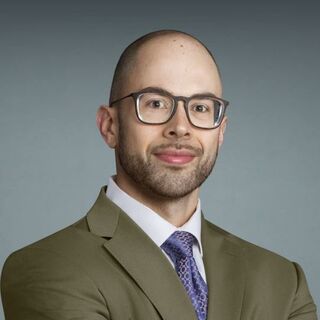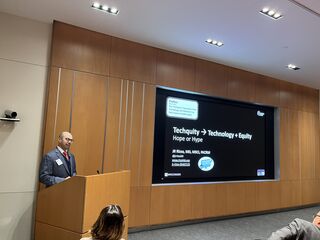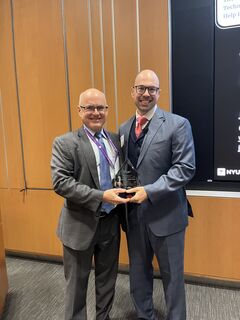NY Researcher’s App Transforms Commuting for the Visually Impaired
Beacon Stories
John-Ross Rizzo, a dedicated New York-based researcher, was confronted with life-altering news at a young age when he was diagnosed with choroideremia. Driven by the obstacles he faced due to his condition, he now stands as a key figure leading the development of advanced assistive technology, with the goal of reshaping the daily commutes of those with low vision and blindness.
By Simone Robinson
John-Ross Rizzo, a native of northern New Jersey, developed a lifelong passion for medicine at a young age. His journey began when he was diagnosed with choroideremia during his formative years, leading him to seek advanced medical treatment in the neighboring city of New York. Fueled by his fascination with the city's diversity and determination to overcome his condition, he forged a successful career in the field of healthcare and rehabilitation.

A close up photo of John-Ross Rizzo in front of a grey backdrop
Before reaching the age of 10, John-Ross's mother noticed some troubling changes in her son's behavior. The typically outgoing child would become withdrawn in the evening while playing outdoors and encountered difficulties with orientation in movie theaters when the lights dimmed, often relying on his mother for guidance. This prompted his mother to embark on a years-long series of visits to a local optometrist in search of answers.
After failing two parametric evaluations to formally assess his peripheral field of vision, John-Ross was referred to a specialist.
“I'll never forget it. After the test, he said to come back tomorrow because you fell asleep. And I said, no, I didn't fall asleep,” John-Ross recalls. “I came back the next day, and I did just as poorly. That's when he said there's something going on here, and we need to get you to a specialist. And that's sort of what started my journey. I bounced around to a series of doctors, and they initially thought I had retinitis pigmentosa. Then I saw Dr. Ronald Carr at NYU, and he took one look at my eyes and said you have choroideremia.”
The condition fueled his passion for a career in medicine, as he found it exceptionally challenging to come to terms with his diagnosis and the incurable nature of the disease.
“I buried that fire in my belly and said I'm going to use this to propel myself forward,” says John-Ross. “As I got older and learned more about my condition, I realized that medicine really needed to be my path, and I figured out what steps would be important. Given the functional limitations I had from my retinal disease, I decided to stay closer to home, but I also wanted to avail myself of all the richness and diversity that New York City had to offer.”
His educational journey In New York City began with the submission of university applications, ultimately securing a scholarship at NYU for his undergraduate studies in neural science. He later pursued his medical doctorate at New York Medical College, only to later return to NYU for his postgraduate studies, where he initiated a career that has spanned 15 years and continues to this day.

John-Ross presenting at the 75th Anniversary of NYU Langone’s Rusk Rehabilitation event
While John-Ross ultimately achieved success, his college journey was far from easy. He reached a point where he had to give up his driver's license, relying on hitching rides and resourcefulness to manage his transportation needs. Today, as a board member of the New York City Metropolitan Transportation Authority (MTA), he has leveraged his experience to create ‘Commute Booster,’ an assistive technology, more specifically a mobile app, designed to improve the lives of individuals with low vision and blindness.
“The MTA infrastructure is so robust, so I knew we had to come up with better ways to leverage such an incredible asset,” he says. “I think commuter rail and subway is probably the most efficient form of travel, and we must make it as accessible as possible for all, not some. So, we started to say, well, what exists in that environment that I know is fixed and stable, and what kind of technologies can we use to better access such environmental information.”
Leveraging General Transit Feed Specification (GTFS) with Optical Character Recognition, the app is designed to assist users in their daily commutes. It achieves this by employing filters to help users navigate their journeys and deliver positive or negative feedback in real-time, depending on whether they are headed in the right or wrong direction, ensuring they are on track to the right platform or exit.
“This is simply taking advantage of the environment that already exists, so there's no fundamental change you need to make,” says John-Ross. “It simply involves using a cell phone and some basic spatial understanding of the subway system (GTFS). As we start to think more earnestly about how we want to support accessibility, it is critical to think about accessibility ‘at-scale’ and what new infrastructure or lack thereof is required to support accessibility across an entire organization. All said, we are working on leaner or more economical ways to better support vulnerable New Yorkers across our whole system, not some, not part and certainly not only here – it must be everywhere.”
As the app progresses in its development and moves towards its first clinical trial, John-Ross highlighted significant partnerships with NYU School of Engineering, MTA, and local non-profit organizations such as Lighthouse Guild and Visions, all of which play a key role in driving the app's progress.

John-Ross standing with Steven R. Flanagan while holding the Howard A. Rusk Leadership and Innovation Award he received from NYU
“Next, we will design a clinical trial to ensure that the technology tests well and garner additional feedback to make sure that we are spot on before we launch,” he says. “We also have a number of other services that we've created over the years and a number of ongoing projects that are nearing completion, blossoming out of their planning stages. Some of them are in the process of technical validations with human-subjects recruitment, which is a critical step to make sure that we’re involving the end users in projects that are designed with scientific rigor. We must launch technology in an optimal state for the commercial marketplace.”
Looking ahead, he plans to maintain his role as an advocate in his community and explore new avenues, leveraging ongoing technological advancements to improve the lives of others. His goal is to create assistive technology that addresses the needs of various populations, particularly the youth.
"My hope for the future is to continue improving the app and integrating it with other technologies so we can better address the needs of the blind and low vision population, as well as other disability populations,” says John-Ross. “By leveraging bleeding-edge technology, we aim to enhance navigation, travel, cooking, and shopping, helping to improve disparities with regards to food insecurity, healthcare inaccessibility, and barriers in the education and employment space. I believe that achieving this involves a symbiotic relationship between technology and equity."




